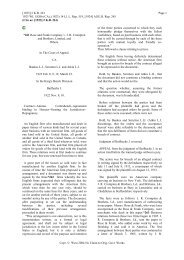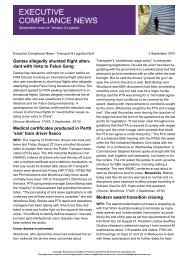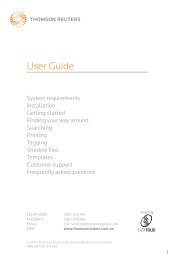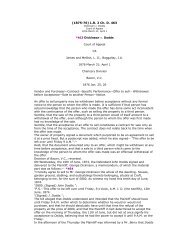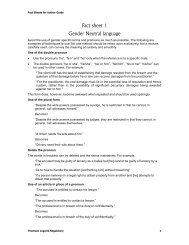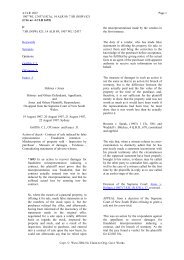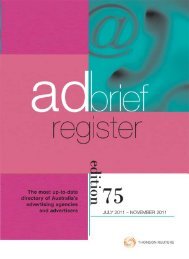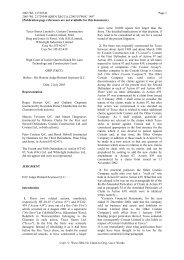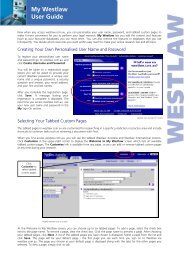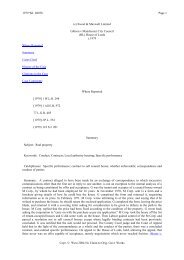Chapter 23: Product Liability - Thomson Reuters
Chapter 23: Product Liability - Thomson Reuters
Chapter 23: Product Liability - Thomson Reuters
Create successful ePaper yourself
Turn your PDF publications into a flip-book with our unique Google optimized e-Paper software.
139Ch <strong>23</strong>: <strong>Product</strong> <strong>Liability</strong>person in the manufacturer’s position would have taken those precautions. 25 Indetermining whether a reasonable person would have taken precautions, thecourt must consider the probability that harm would occur if care were nottaken, the likely seriousness of the harm, the burden of taking precautions toavoid the risk of harm and the social utility of the activity that creates the risk ofharm. 26 These statutory formulations should make it more difficult to establishliability in negligence than was formerly the case under the unamended commonlaw.Design defects present greater problems of proof and policy. Since the designitself is challenged, the standard of reasonable safety to which it should conformis not a “given” (unless laid down by statute) 27 but must be determined bybalancing the risk of harm against the cost of reducing or preventing it by analternative design. This presents little difficulty where the design is selfdefeating,like a collapsing crane, 28 inflammable heat cladding, 29 or a brittle jarfor sulphuric acid. 30 In other cases, a safer design, such as provision of a guardon a lawnmower 31 or a bridge communication system on a floatingrestaurant, 32 might have reduced or negated the risk, although the statutoryformula for considering whether precautions ought to have been taken mustalways now be borne in mind. 33Much more complex are cases where the particular design did not cause theaccident but at most failed to protect against its consequences, for example incomplaints that a car was not crashworthy, that is, did not offer sufficientprotection in a collision caused by the driver’s or a third party’s negligence. 34 Inprinciple, that should be no obstacle, since it is well established that negligencemay consist in failing to avoid aggravation of injuries, as by omitting to wear aseatbelt. 35 Typically the design is the outcome of a conscious choice, often madeby the manufacturer on the basis of relative cost so as to accommodateconsumer preferences or even the public interest (for example, lightweight carsoffer less collision protection but are cheaper and save petrol).25 Civil Law (Wrongs) Act 2002 (ACT), s 43(1); Civil <strong>Liability</strong> Act 2002 (NSW), s 5B(1); Civil<strong>Liability</strong>Act 2003 (Qld), s 9(1); Civil <strong>Liability</strong>Act 1936 (SA) s 32(1); Civil <strong>Liability</strong>Act 2002(Tas), s 11(1); Wrongs Act 1958 (Vic), s 48(1); Civil <strong>Liability</strong> Act 2002 (WA), s 5B(1),discussed [x.xxx].DRAFT26 Civil Law (Wrongs) Act 2002 (ACT), s 43(2); Civil <strong>Liability</strong> Act 2002 (NSW), s 5B(2); Civil<strong>Liability</strong>Act2003 (Qld), s 9(2);Civil<strong>Liability</strong>Act1936 (SA), s 32(2);Civil<strong>Liability</strong>Act2002(Tas), s 11(2); WrongsAct 1958 (Vic), s 48(2); Civil <strong>Liability</strong>Act 2002 (WA), s 5B(2).27 The Competition and Consumer Act 2010 (Cth), Part V Div 1A provides for the declarationand enforcement of product safety and information standards and the publication of warningnotices about hazardous products.28 Rivtow Marine Ltd v Washington Iron Works [1974] SCR 1189.29 Bow Valley Husky (Bermuda) Ltd v Saint John Shipbuilding Ltd [1997] 3 SCR 1210.30 Adelaide Chemical Co v Carlyle (1940) 64 CLR 514.31 Shepherd v S J Banks (1987) 45 SASR 437.32 Podmore vAquatours Pty Ltd [1984] 1 NSWLR 111.33 Above n 26.34 For example, Larsen v General Motors Corp, 391 F 2d 495 (8th Cir 1968); Gallant v Beitz(1983) 148 DLR (3d) 522.35 Froom v Butcher [1976] QB 286; Eagles v Orth [1975] Qd R 197. In the Australian CapitalTerritory, New South Wales, South Australia and Tasmania, legislation mandates a finding ofcontributory negligence on the part of a plaintiff who failed to wear a seat belt: Civil Law(Wrongs) Act 2002 (ACT), s 97; Motor Accidents Compensation Act 1999 (NSW),s 138(2)(c), (d); Civil <strong>Liability</strong> Act 1936 (SA), s 49; Motor Accidents (Liabilities andCompensation)Act 1973 (Tas), s 22(4).session: 5 October 28, 2010 page no: 4 folio no: 139@syd-tlrapp-p19/syd-tlrapp-p191/CLS_law/GRP_flemings/JOB_update10/DIV_19PROOF COPY



